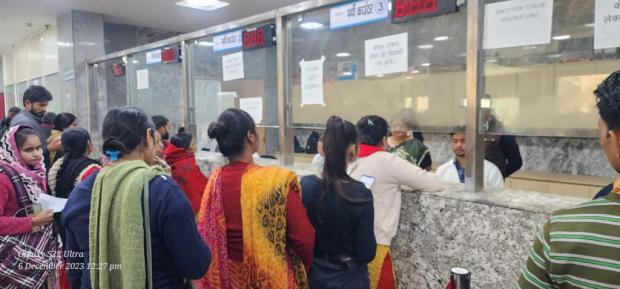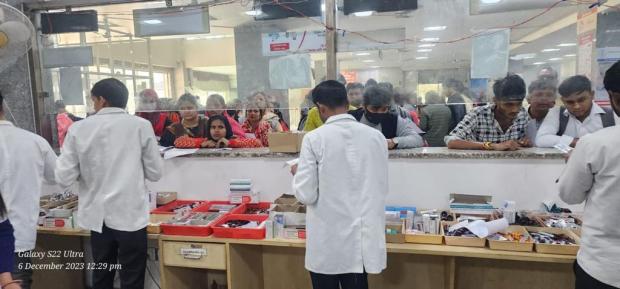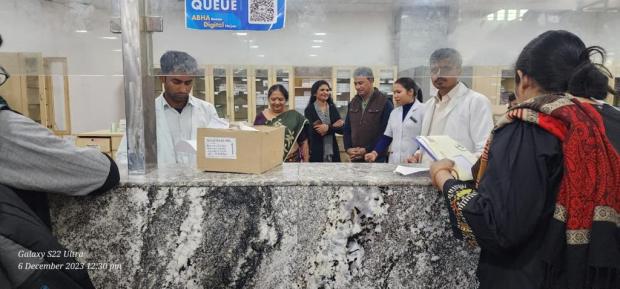A visit to the Out Patient Department (OPD) in any hospital is a tedious affair. Long queues, multiple reports and cluelessly hoping from one department to another can be very challenging.
To address these issues, the National Health Authority (NHA) launched a paperless digital OPD scheme under the under the Ayushman Bharat Digital Mission (ABDM) in 2022. The aim of this ‘Scan and Share’ service is to ensure quick registration and reduce waiting time during rush hours.
The NHA initiated the pilot project at the OPD block of Lady Hardinge Medical College (LHMC) and Smt. Sucheta Kriplani Hospital (SSKH) in New Delhi. According to the Ministry of Health and Family Welfare, the service allows both old as well as new patients to simply scan a QR Code and share their demographic details like name, father name, age, gender, address, mobile number etc. with the hospital.

The main objective of this scheme to reduce the time taken at the OPD registration counter, provides accurate data in the hospital record and, most importantly, avoids the wait in the long queues. Ever since the launch, the programme has witnessed an increase in adoption among various hospitals across in India.
In October 2023, the Health Ministry announced that NHA has generated more than 1 crore tokens for OPD registrations using the ABHA-based Scan and Share service. The service is now active in more than 2,600 health facilities across 419 districts in 33 states and union territories of India. Interestingly, the state of Uttar Pradesh, Karnataka, and Jammu & Kashmir are among the leading states which are using this facility for providing better service delivery to patients. Every hospital that implemented this scheme witnessed an increase in efficiency and improved patient care and managment.
In Uttar Pradesh’s Gautam Budh Nagar, CMS District Hospital achieved a remarkable feat of implementing this scheme and it helped them in the management of the massive footfall.

“I joined as CMS District Hospital, Gautam Budh Nagar in June 2023 and focused my efforts towards revitalizing and revamping the hospital facilities. We were able to restart the 21 bedded ICU facility, establish 24 hour X- Ray and lab services along with 24 hour ARV Services. By implementing these facilities, our daily OPD attendance jumped from 1200 to 3000. Patients would flock at our hospital and the overflowing patient load would queue up from the registration counter to outside the hospital. The management of such enormous a crowd became a challenge for us,” Dr. Renu Aggarwal, CMS District Government Combined Hospital, Gautam Buddha Nagar, UP told Financial Express.com.
Dr. Aggarwal informed that they implemented the ABHA-based Scan and Share service in September last year.
“…We immediately saw a considerable reduction in thelong OPD queues that helped us manage the patients spatially and more efficiently and this in turn proved to be a boon to the patients,” she revealed.
She also revealed that although the impact and outcomes has been remarkable there has been challenges in the way too. “In the initial days, our team would help them and teach them how to register on the PHR app using their mobile phones, which required a lot of persuasion. We still face challenge with the patients who do not have smartphones,” she added.
As more and more people started understanding the system better, the impact of the scheme in the hospital became more evident.
“We started achieving about 2000 online tokens daily and soon achieved 2nd position consistently in the daily national ranking (after AIIMS Delhi). Some of the challenges we faced in our endeavours were the lack of dedicated manpower to implement the service. It took a lot of patience and counselling to create awareness amongst the patients about Scan and Share service and to convince them to register online for ABHA ID,” Dr. Aggarwal told Financial Express.com.
In order to implement the the service effectively, the hospital management created a separate counter and diverted the manpower.
“We created a separate counter, apart from the dedicated OPD registration counter and diverted manpower to facilitate the online registration and token system. Due to a shortage of individuals dedicated to this program, considerable forethought was required to reallocate employees from various paramedical positions to this initiative. We motivated and encouraged the workers for teamwork and they started putting in extra hours, which helped us to carry out the herculean task smoothly. The consistent rewards in the form of national ranking, motivated them to voluntarily come 2 hours early to work,” she explained.

She also revealed that the hospital is now able to serve more patients within the same time and with the same facilities. “The patients are also appreciating the convenience. By avoiding the need to stand in the long hospital queue, they’re saving time and also encouraging others to use the service,” she added. Interestingly, on many ocassions, the repeat patients are also helping the new ones to use Scan and Share to book their OPD tokens.
It is noteworthy that this scheme is able to reduce the average waiting time from 50 minutes to five minutes in some hospitals. Consequently, it has made OPD visits for the patients a hassle-free experience.
How does ABHA’s ‘scan and share’ OPD scheme work?
The QR code-based OPD registeration scheme is currently active in 33 states and 453 districts. In order to access the OPD registeration service, the patients need to create an Ayushman Bharat Health Account (ABHA). Here are the steps:
- To create an Ayushman Bharat Health Account (ABHA), validate the Aadhaar card or driving license from: https://healthid.abdm.gov.in/register
- This will further generate a 14-digit code that will validate the user as a participant in India’s digital healthcare ecosystem.
- After this, patients need to log in to health applications like the Arogya Setu app, Bajaj Health or the ABHA app on their mobile devices.
- After successfully logging into the applications, patients can simply scan the QR code available at various government hospitals in India and share their ABHA number with the hospital.
- With this, the Hospital Management Information System will be able to access all the personal info like name, age, gender, guardian’s name, address, mobile number and others, necessary for the OPD registration process.
- The patient can now just simply collect their outpatient slip and visit the doctor.
Interestingly, in order to promote the adoption of Scan and Share service by hospitals and the Digital Solution Companies (DSCs) offering their technology to the health facilities, NHA also offers incentives for Scan and Share transactions under ABDM’s Digital Health Incentive Scheme (DHIS).









